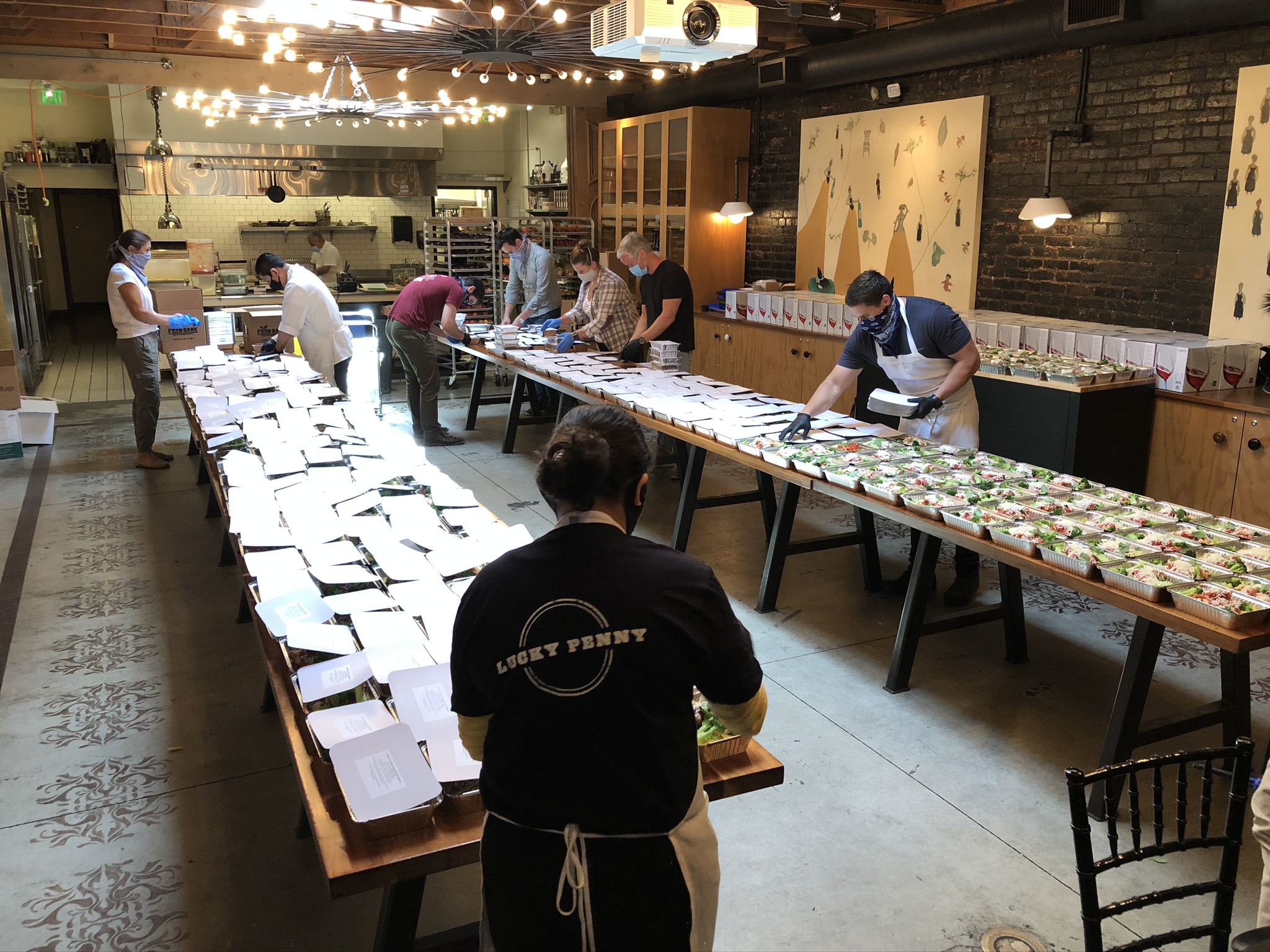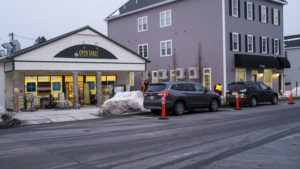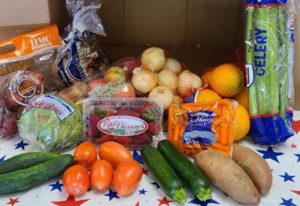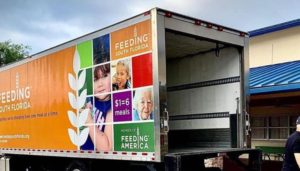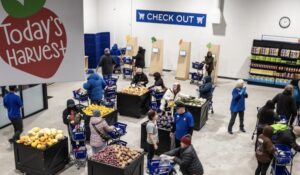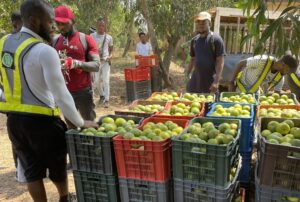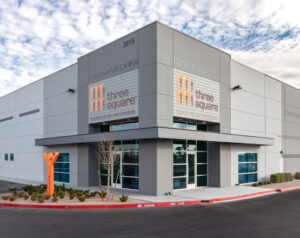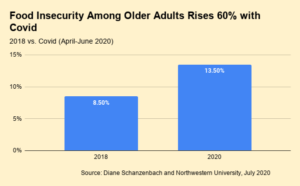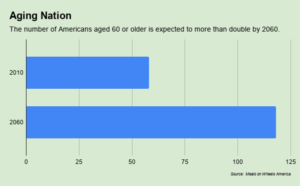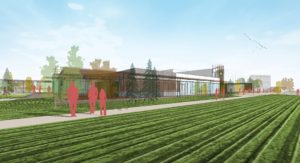Second Harvest Heartland of Minnesota and others are proving that a food bank does not necessarily need a kitchen to play a major role in distributing thousands of freshly prepared meals.
Using Feeding America’s MealConnect platform, Second Harvest Heartland is sourcing large donations of bulk food and guiding it toward nearby commercial kitchens where it can be prepared. Since mid-March it has coordinated the rescue of more than 550,000 pounds of food to help create more than 300,000 meals, and is currently behind the distribution of more than 40,000 meals a week.
Meal preparation addresses multiple ills of the pandemic — by employing furloughed restaurant workers, finding new outlets for large-scale food distributors with ruptured supply chains, and getting much-needed meals to hungry people. Other food banks tackling similar missions but on a smaller scale include Second Harvest Food Bank of Middle Tennessee and Foodbank of Santa Barbara County. In addition, Feeding Tampa Bay is using a combination of its own kitchen and four other restaurant kitchens around town to produce about 8,500 meals a day.

Second Harvest Heartland’s model follows one set by Jose Andres and his World Central Kitchen, who by chance, had spoken at a Second Harvest Heartland event just two weeks before the pandemic shutdown. “It was just a strange coincidence,” noted Dianne Wortz, Food Rescue Emerging Streams Developer at Second Harvest Heartland. With the pandemic, the food bank was suddenly confronted with the unexpected possibility of building its own meal-prep operation. “We started that following week — almost immediately,” Wortz said. In keeping with the example set by Andres, the food bank named its operation Minnesota Central Kitchen.
Before the pandemic, about 150 kitchens associated with Second Harvest Heartland were participating in a version of Feeding America’s MealConnect software, available since 2018, in which restaurants can donate prepared meals and have volunteer drivers pick them up and deliver them to various meal programs around town. Upon the shutdown, an additional 175 or so kitchens immediately signed up to donate their excess food through MealConnect.
In addition, calls started coming from distributors that had lots of food but no outlets for it. Minnesota Central Kitchen also began tapping into the Feeding America network, acquiring for example, truckloads of chicken and pork, which it stored at a second warehouse.
Within days of the shutdown, Chowgirls Catering, an early user of MealConnect and long-time partner of Second Harvest Heartland, began cooking. Soon, five sites including a brewery and two corporate kitchens were on board, employing 100 food-service workers and getting Minnesota Central Kitchen up to that clip of nearly 41,000 meals per week. The meals are distributed to-go style through Loaves and Fishes, one of the food bank’s larger agency partners with 37 congregate dining sites across the state.
In California, Foodbank of Santa Barbara County combined a focus on feeding seniors in need with a desire to help shuttered restaurants to create a program called Chef’s Kitchen. Working with local chefs and restaurants, it’s behind the preparation and delivery of about 700 meals a week to homebound seniors.
The program expands upon a service that delivers groceries to seniors’ homes, which has grown four- to five-fold to about 8,000 seniors since the arrival of Covid-19. Some seniors were unable to open the canned food or handle the fresh produce, highlighting a need for prepared meals, said Lacey Baldiviez, PhD, Director of Community Programs & Education. A student-led group called Zoomers to Boomers helps to deliver the meals for free.
In Nashville, seven notable chefs are working with Second Harvest Food Bank of Middle Tennessee to prepare 2,200 meals a week for distribution through the food bank’s partner agencies. The food-delivery service Sysco picks up the prepared meals from each restaurant and delivers them to the food bank’s partner agencies Monday through Friday.
As a high-touch service, meal preparation and delivery doesn’t always fit neatly into a set budget. Foodbank of Santa Barbara County’s Chef’s Kitchen is a “very expensive program,” Baldiviez acknowledged. “We’re doing as much as we can.” At the same time, the cause is striking a chord with donors who not only want to keep seniors safe, but also support their beloved restaurants, she said.
The food banks are employing different models in their financial arrangements with the restaurant kitchens. At Minnesota Central Kitchen, three of the kitchens are being paid per meal, and are heavily dependent on the donated product Minnesota Central Kitchen is finding. “That is keeping their costs down and allowing us to operate for a longer period of time,” Wortz said. In addition, corporate kitchens at Cargill and United Health Group have been producing and donating meals at no charge to the food bank, relying on their existing contracts with distributors to acquire food.
At Foodbank of Santa Barbara County, the restaurants are procuring their own food, often from local farms, with funding provided by the food bank. “They charge us $10 per meal and we order how many we need, 500 to 700 per week,” Baldiviez said. The food bank has coached the restaurants to steer clear of rich, sodium-heavy dishes and embrace lower-cost meals that can be easily reheated in a microwave oven. “They’re not used to serving a senior population, so there was a little learning curve,” Baldiviez explained.
In Nashville, Second Harvest Food Bank of Middle Tennessee is providing the food to create the meals, while the individual restaurants are supplying additional ingredients. To help compensate restaurant staff, the local conventions bureau raised $120,000 in Visa gift cards.
Second Harvest Heartland does not expect that its foray into meal prep will result in it building its own kitchen, Wortz said, though the food bank does hope that at least 75% of the 175 kitchens that just signed up on MealConnect will continue with the program.
Foodbank of Santa Barbara County, meanwhile, is eager to explore how a proprietary kitchen could support meal preparation for seniors as well as school kids, and also act as a teaching kitchen to improve food literacy. “It was an idea we had kicked around, and this has definitely accelerated it,” Baldiviez said.
CAPTION ABOVE: Meal prep at a restaurant partner of the Foodbank of Santa Barbara County.
